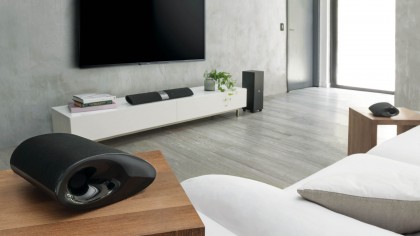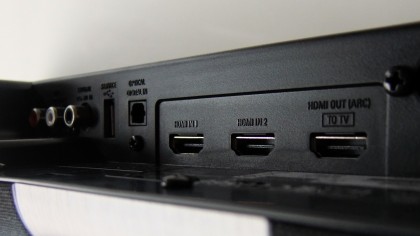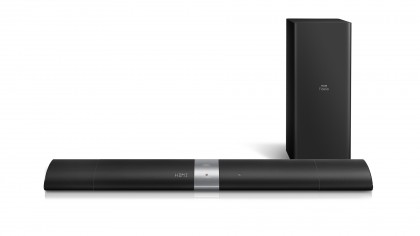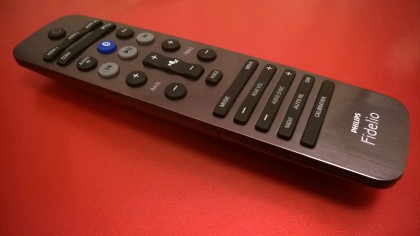TechRadar Verdict
The Fidelio B5's ability to instantly transform from a traditional soundbar into a wireless surround system makes it a seriously smart bit of kit. It may not be super-loud, but it offers quality, usability and versatility in spades.
Pros
- +
Instant surround sound
- +
Versatile Bluetooth speakers
- +
Easy to use
Cons
- -
Massive as a single bar
- -
Quite pricey
- -
Weak stereo sound
Why you can trust TechRadar
The Fidelio B5 is like the Optimus Prime of soundbars. Actually, scratch that. It's way better than the stuffy old Autobot. The Fidelio B5 is like jazz. It's cooler, still has that Transformer vibe, and packs a whole lot more funk in its trunk.
You see, Philips' curvaceous soundbar has a seriously powerful USP: it can switch from traditional soundbar to 4.1 surround sound system in seconds.
At first glance it might look like an ordinary soundbar, with a wireless subwoofer and front-firing speakers, but yank the end units off either side and they become individual wireless satellite speakers that you can place around your room to give you a more cinematic effect.
The switch from 2.1 system to 4.1 surround takes a single beat, and the B5 automatically switches into its cinema mode without you having to do anything. It's even rocking some impressively simple room calibration tech, which dynamically adjusts the levels in the surround channels to cope with offset placement around your room.
It's this ease of use which is the hallmark of the Philips Fidelio B5.
In each of the detachable end-speakers is a single, full-range 3-inch driver, and a lithium-ion battery that's capable of delivering around 10 hours of charge when running wirelessly.

Design
The base soundbar is left with a further pair of 3-inch drivers to make up the two central channels, as well as a pair of 1-inch soft dome tweeters to take care of the high-end audio details.
Sign up for breaking news, reviews, opinion, top tech deals, and more.
The wireless 6.5-inch subwoofer is a down-firing affair to bring depth to the cinema sound. It's also got a relatively small footprint, enabling it to be stowed discretely out of sight.
Connectivity is straightforward enough, with aptX Bluetooth for music playback, and coaxial, analogue 3.5mm and digital optical inputs as well as a HDMI 1.4 ARC output. It also features a pair of HDMI inputs, enabling you to connect multiple devices.

But the B5's transforming skills don't stop at its 2.1 to 4.1 transition. Each of those detachable speakers can become individual Bluetooth speakers in their own right – both have a discrete Bluetooth module inside, enabling them to be used independently of the main bar.
With both speakers placed in separate rooms (because we all hate soundclash, right?) you can then have three different audio sources playing between the discrete satellite speakers and the main soundbar unit.
When you detach the speakers from the centre section a pair of buttons are revealed which enable you to switch from surround to Bluetooth mode quickly and easily. And they're rocking the now-standard aptX support, so you can get its full CD-quality audio capabilities across the wireless connection.

The speakers aren't that powerful on their own, however. Each is only rated at 8W, so they won't be shaking the room by themselves, but they're still able to deliver a decent audio range.
Performance
The audio performance of the Philips Fidelio B5 is impressive, whether it's being used as a traditional 2.1 soundbar or in its more flexible 4.1 configuration.
The clarity of sound, from the constant rumbling bass of a Michael Bay 'splode-a-thon to dialogue-heavy dramas to detailed hi-res music, is excellent. That wireless sub does a great job of adding depth to the sound while those soft dome tweeters, mixed with Philips' Crystal Clear Sound processing, keep the aural experience precise and defined.

But how does its headline-grabbing transformation work in practice? Pretty darned well, if I'm honest.
One of the biggest reasons for not having a surround sound system in place at home is the fact that those satellite speakers always end cluttering up the room and getting in the way.
Wired solutions need a whole lot of planning to avoid a chaotic, tangled mess stretching around the lounge like Cthulu's own tentacles, and even wireless options can be a pain with their need for regular charging.
Having a setup that can house and charge its wireless satellites in a convenient place, and still allow you to switch almost instantly to a surround sound setup, is more than welcome.
Simple surround
The other reason to opt for soundbars over complicated surround sound arrays is all about simplicity, and the Fidelio B5's unplug and play system is seriously slick.
All you have to do is pull the satellite speakers from their docks; the B5 automatically switches to surround mode, and you can move the speakers around the room as you see fit.
The surround sound performance itself isn't earth-shatteringly good, but it is effective – although you're never going to get the precision of a proper Dolby Atmos kit or a 7.1 array.
Of course, if you're that desperate for the ultimate in spatial audio then you'll be prepared to drill out your walls to install the satellites, and carve out holes in the ceiling, to create that 3D aural experience.
The rest of us just want something quick, easy and with a decent approximation of cinema sound, which is what Philips has created with this soundbar.

And, if you're listening to music rather than marvelling at Jessica Jones, you can switch from 'Movie' to 'Music' mode with a touch on the elegant remote control. This then alters the signal to deliver the full audio around the room, rather than just the surround channels.
That remote also enables you to adjust bass and treble, as well as nudge the audio synchronisation if the image and sound are falling out of step.
